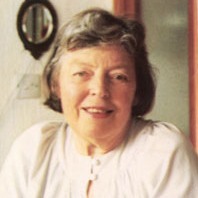Twm Siôn Cati is a figure in Welsh folklore.

A cookbook or cookery book is a kitchen reference containing recipes.
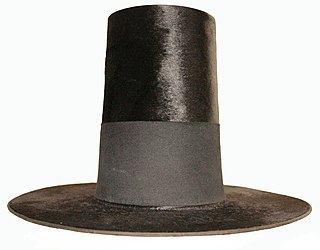
The Welsh hat worn by women as part of Welsh national costume is a tall hat, similar to a top hat, or the capotain. It is still worn by Welsh folk-dance women, and schoolgirls, in Wales on St David's Day, but rarely on other occasions.

Augusta Hall, Baroness Llanover, born Augusta Waddington, was a Welsh heiress, best known as a patron of the Welsh arts.

Cawl is a Welsh dish. In modern Welsh the word is used for any soup or broth; in English it refers to a traditional Welsh soup, usually called cawl Cymreig in Welsh. Historically, ingredients tended to vary, but the most common recipes are with lamb or beef with leeks, potatoes, swedes, carrots and other seasonal vegetables. Cawl is recognised as a national dish of Wales.

The crempog is a Welsh pancake made with flour, buttermilk, eggs, vinegar and salted butter. Traditionally made on bakestones or griddles, the crempog is one of the oldest recipes in Wales. They are also known as ffroes, pancos and cramoth and are normally served thickly piled into a stack and spread with butter. It is traditionally served at celebrations in Wales, such as Shrove Tuesday and birthdays.

Eliza Acton was an English food writer and poet who produced one of Britain's first cookery books aimed at the domestic reader, Modern Cookery for Private Families. The book introduced the now-universal practice of listing ingredients and giving suggested cooking times for each recipe. It included the first recipes in English for Brussels sprouts and for spaghetti. It also contains the first recipe for what Acton called "Christmas pudding"; the dish was normally called plum pudding, recipes for which had appeared previously, although Acton was the first to put the name and recipe together.
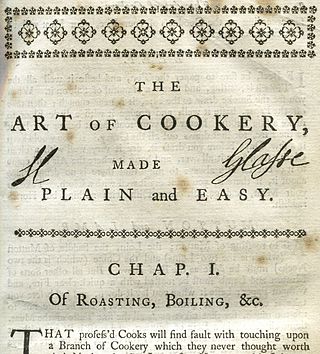
Hannah Glasse was an English cookery writer of the 18th century. Her first cookery book, The Art of Cookery Made Plain and Easy, published in 1747, became the best-selling recipe book that century. It was reprinted within its first year of publication, appeared in 20 editions in the 18th century, and continued to be published until well into the 19th century. She later wrote The Servants' Directory (1760) and The Compleat Confectioner, which was probably published in 1760; neither book was as commercially successful as her first.
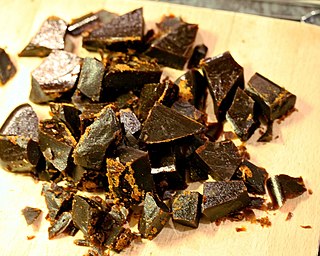
Bonfire toffee is a hard, brittle toffee associated with Halloween and Guy Fawkes Night in the United Kingdom. The toffee tastes very strongly of black treacle (molasses), and cheap versions can be quite bitter. In Scotland, the treat is known as claggum, with less sweet versions known as clack. In Wales, it is known as loshin du. The flavour is similar to that of butterscotch, although it is a toffee and never a viscous liquid.
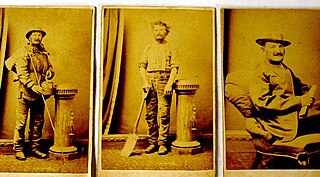
Joseph Jenkins, was an educated tenant farmer from Tregaron, Ceredigion, mid-Wales who, when aged over 50, suddenly deserted his home and large family to seek his fortune in Australia. The Australian Dictionary of Biography says that "Jenkins's noteworthiness stemmed from the rich documentation of his experiences and thoughts that has survived". He was a consistent diarist for 58 years of his life and an award-winning poet, under the bardic name of Amnon II. He achieved fame posthumously from publication of some excerpts of his Australian writings. The compiler, his grandson Dr William Evans, a Harley Street cardiologist, coined the title Diary of a Welsh Swagman by which name he is familiar to generations of Victoria school students for whom the book became a prescribed history text in 1978.

Onion cake is a savory or sweet cake prepared using onion as a primary ingredient. Various onion cakes are consumed in Canada, China, Germany, Korea, Switzerland, Wales and other countries. Several types and varieties of onion cakes exist, including laobing, pajeon, the scallion pancake, Edmonton-style green onion cake, teisen nionod and zwiebelkuchen.
Gilli Davies is a Cordon Bleu cook from Wales. Davies has been involved with food, food journalism and broadcasting since about 1975.

Welsh cuisine encompasses the cooking styles, traditions and recipes associated with Wales. While there are many dishes that can be considered Welsh due to their ingredients and/or history, dishes such as cawl, Welsh rarebit, laverbread, Welsh cakes, bara brith and Glamorgan sausage have all been regarded as symbols of Welsh food. Some variation in dishes exists across the country, with notable differences existing in the Gower Peninsula, a historically isolated rural area which developed self-sufficiency in food production.

Pembrokeshire has been called "the cottage garden of Wales", due to its good soil and the beneficial effects of the Gulf Stream, which provide a mild climate and a longer growing season than other parts of the country. The good climate and soil meant that the south of the peninsula was coveted by the Norsemen and Normans because it had "great plentie" of corn and cattle The county has prime agricultural land, much of which is located at about 70m above sea level, while to the north, the Preseli Hills rise to 500m above sea level and form uplands that are made up of heather and bracken, which are used for grazing sheep. Consequently, Pembrokeshire is classed as one of the most fertile counties in Wales, with its 392,300 agricultural acres having 14% of its land classed as of good quality, 67% being classed as medium quality and 19% being classed as poor quality. However, agricultural production is subject to market forces and in the 1890s, as a result of the Panic of 1893, a deep agricultural depression led to the area under cultivation falling by a third. Many labourers and farmers had no option but to emigrate to the New World and many of the large farming estates were sold. World War I brought prosperity again, but by the 1930s, as a result of the Great Depression, there was another agricultural depression which lasted until World War II. During the Post-war period agriculture has benefited from marketing schemes and marketing boards, which have helped in the regulation, marketing and distribution of the county's agricultural production.
The coast of Ceredigion is made up of a long coastal plain that contains high cliffs, coves, large bays and estuaries. The coastal plain gets narrower towards the more mountainous north of the county and is cut by the wide estuaries of the Teifi and the Dyfi. The broad and fertile Teifi valley is ideal for dairy farming and mixed farming. Heavy rainfall washes the minerals out of the soil and results in the mountainous areas of the county having relatively poorer, acidic soils. The plough line can be as low as 700 feet, which restricts cultivation.
Alice Matilda Langland Williams, more commonly known as Alys Mallt and Y Fonesig Mallt, was a Welsh political writer and celtophile. She was born in Brecknockshire to an English-speaking family, but learned the Welsh language when influenced by the circle of Welsh heiress Augusta Hall, Baroness Llanover.

The cuisine of Monmouthshire is historically associated with Lady Augusta Hall, who was also known as Lady Llanover. Lady Llanover published one of the first Welsh cookery books called First Principles of Good Cookery. The book uses a fictional Welsh hermit to give culinary advice to a visiting guest who is travelling though Wales.

Margaret Jones was a 19th-century Welsh travel writer whose work was published under the pseudonym Y Gymraes o Ganaan.
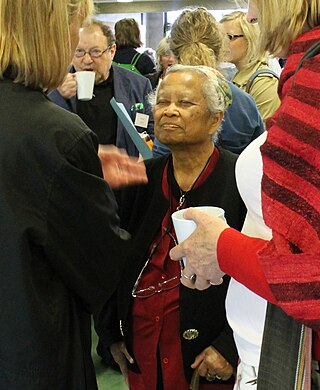
Sri Owen is an Indonesian cooking teacher and food writer, based in London for most of her life. She is the author of the first English-language recipe book dedicated to the food of Indonesia, and is recognised as a leading authority on Indonesian cuisine.
